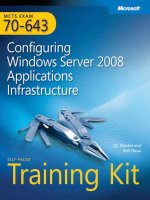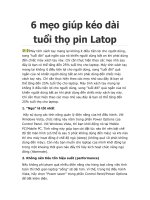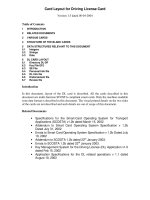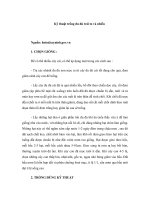Tài liệu FSM Telecom, Micronesia: Providing Mobile Services to Remote Islands doc
Bạn đang xem bản rút gọn của tài liệu. Xem và tải ngay bản đầy đủ của tài liệu tại đây (95.21 KB, 2 trang )
CASE STUDY
FSM Telecom, Micronesia:
Providing Mobile Services to Remote Islands
In a remote area of the Pacific Ocean lie the Federated States of
Micronesia—607 individual islands and atolls scattered over one million
square miles, but with a total land area of only 271 square miles.
Four main islands are home to the majority of the 110,000 residents
and represent the region’s economic and commercial hubs. FSM
Telecom, the incumbent telecom provider for the islands, has been
offering voice, internet and data services over its wired network since
1983. However, for a number of years, it had wanted to build a cellular
network to meet specific requirements, such as providing customers
with mobility for voice and internet services, especially in the marine
community (fishing and boating are a large part of everyday life in FSM)
and reaching areas where it is too costly to extend its wired network.
FSM Telecom also had other unique considerations including avoiding
expensive inter-island satellite backhaul and withstanding a tropical sea
environment that produces extreme moisture, corrosion, heat,
and humidity.
Over the years, they explored the possibility of building a cellular
network many times but traditional large scale cellular networks
offered by the various infrastructure providers were simply too large
and expensive to serve the citizens of Micronesia.
CASE STUDY
Website: www.adc.com
From North America, Call Toll Free: 1-800-366-3891 • Outside of North America: +1-952-938-8080
Fax: +1-952-917-3237 • For a listing of ADC’s global sales office locations, please refer to our website.
ADC Telecommunications, Inc., P.O. Box 1101, Minneapolis, Minnesota USA 55440-1101
Specifications published here are current as of the date of publication of this document. Because we are continuously
improving our products, ADC reserves the right to change specifications without prior notice. At any time, you may
verify product specifications by contacting our headquarters office in Minneapolis. ADC Telecommunications, Inc.
views its patent portfolio as an important corporate asset and vigorously enforces its patents. Products or features
contained herein may be covered by one or more U.S. or foreign patents. An Equal Opportunity Employer
106324AE 4/08 Original © 2008 ADC Telecommunications, Inc. All Rights Reserved
Then at the end of 2001, FSM Telecom discovered
ADC’s compact GSM and CDMA systems for
developing countries and hard-to-serve areas.
The result was that FSM Telecom could cost-
effectively build small-scale networks throughout
the islands that could contend with the extreme
climate conditions. In addition, satellite backhaul
is optimized and implemented cost-effectively due
to the advanced compression technology in the
ADC system.
Because ADC’s cellular networks are quick to
deploy and highly scalable, FSM Telecom could
realize revenues almost immediately by building
in the most profitable areas first - and then
expanding the network at a later date.
The ADC Wireless network—
reducing satellite backhaul
Using the UltraWAVE product family, a wireless
network was installed for FSM with mobile
switching centers (MSCs) on the four main
Micronesian islands, each of which are 250 miles
apart. With intra-island traffic being switched
locally, only inter-island traffic was required to
be backhauled via satellite. With ADC’s advanced
compression technology even those costs were
dramatically minimized. Base station controllers
(BSC) and base transceiver stations (BTS) were
also installed on the four main islands with
international traffic aggregated and routed
through the main hub on the largest island
of Pohnpei for further savings.
Rapid Deployment and Expansion
Within six months of the first meeting with
FSM, its cellular network was up and running
with more than 3,000 subscribers. The network’s
support of pre-paid services eliminates credit
problems while making it easy and quick for new
customers to start using the service. And visitors
to the islands can either buy a prepaid phone
when they arrive or use their own tri-band
phone after buying a prepaid SIM card. Either
way, it’s an innovative business model that
works for FSM. Given the success of the initial
deployment, FSM Telecom is now planning
the expansion of the network to the outer
islands where there is no wired infrastructure.
For example, FSM Telecom is evaluating the
deployment of ADC’s innovative Network-In-a-
Box technology on the remote island of Ulithi,
which has only 176 households. This network
would be solar powered and would include a
small, efficient IP satellite connection to provide
the island with Internet and voice services.
Results
Mobile telephone services available for the first •
time in the FSM
Lower CAPEX costs coupled with tremendous •
growth in usage enabled FSM Telecom to have
quick return on investment and realize greater
revenues
Mobile network which minimizes the use of •
expensive satellite backhaul
Plans for expansion to provide mobile and •
wireless services to FSM’s outer islands that
have no existing fixed or wireless networks
About FSM Telecom Corporation
Established in 1983, it is the sole provider of
telecommunications in the Federated States
of Micronesia (FSM) FSM Telecom has built
a variety of wired and wireless networks over
which it offers voice, Internet and data services
to homes and businesses located on islands
that are home to most of FSM’s population
and commercial centers.









